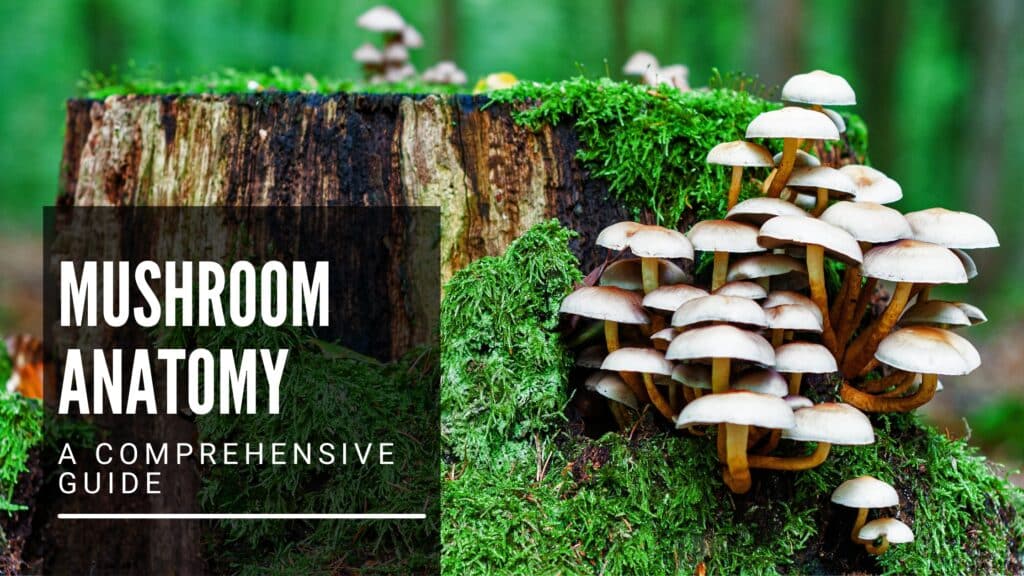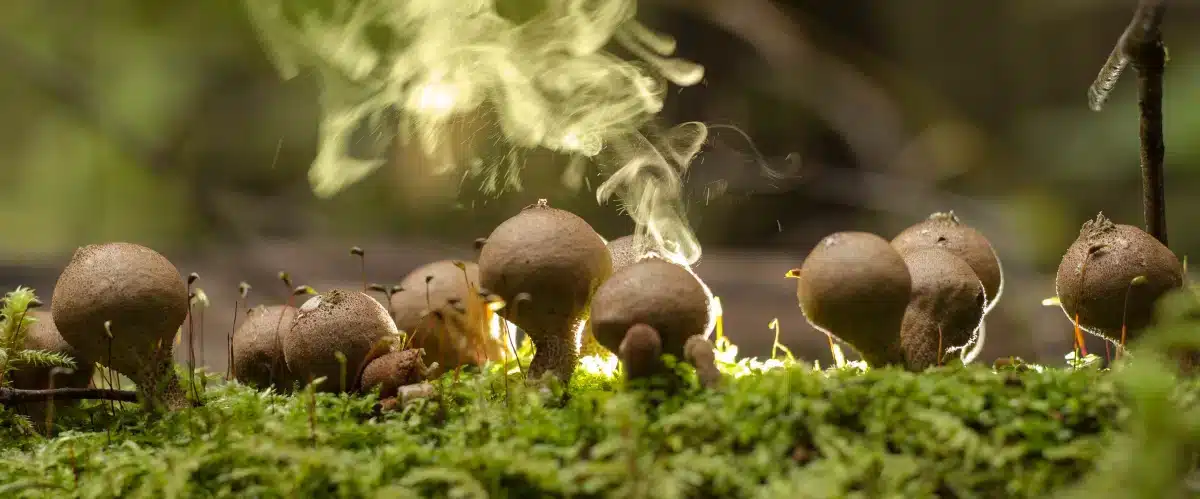Mushrooms capture the imagination with their mysterious allure and complex structures. These organisms are not just a fascinating ecological phenomenon but are also integral to the balance of ecosystems where they thrive. This guide dives into the anatomy of a mushroom, shedding light on each part and its purpose, which goes far beyond what meets the eye.
From the visible cap and stem to the hidden networks of mycelium beneath the soil, mushrooms offer a glimpse into the intricate connections within nature. By understanding these parts, we not only fulfill a natural curiosity but also enhance our ability to identify, utilize, and protect these essential organisms. Whether you are a seasoned forager, a passionate mycologist, or simply a nature enthusiast, knowing the structure of mushrooms can enrich your outdoor experiences and appreciation of the natural world around us.
Join us as we explore the complex anatomy of mushrooms, discovering the role each part plays in their growth, survival, and the broader ecological tapestry. This journey will not only deepen your knowledge but also inspire a greater appreciation for the often overlooked details that make nature endlessly fascinating.
Quick Summary
- Cap (Pileus): Serves as a protective cover, with various shapes and colors across species.
- Gills (Lamellae): Facilitate spore dispersal, crucial for fungal reproduction.
- Spores: Key reproductive units, identified by unique colors aiding in classification.
- Stem (Stipe): Supports the cap and assists in elevating it to spread spores.
- Veil (Partial and Universal): Protects developing gills, with remnants aiding in species identification.
- Volva: Found at the base, critical for identifying certain species like Amanitas.
- Mycelium: The feeding and growth network of fungi, integral to nutrient absorption.
- Rhizomorphs: Help in nutrient transport, vital for fungal spread and survival.
1. Cap (Pileus)
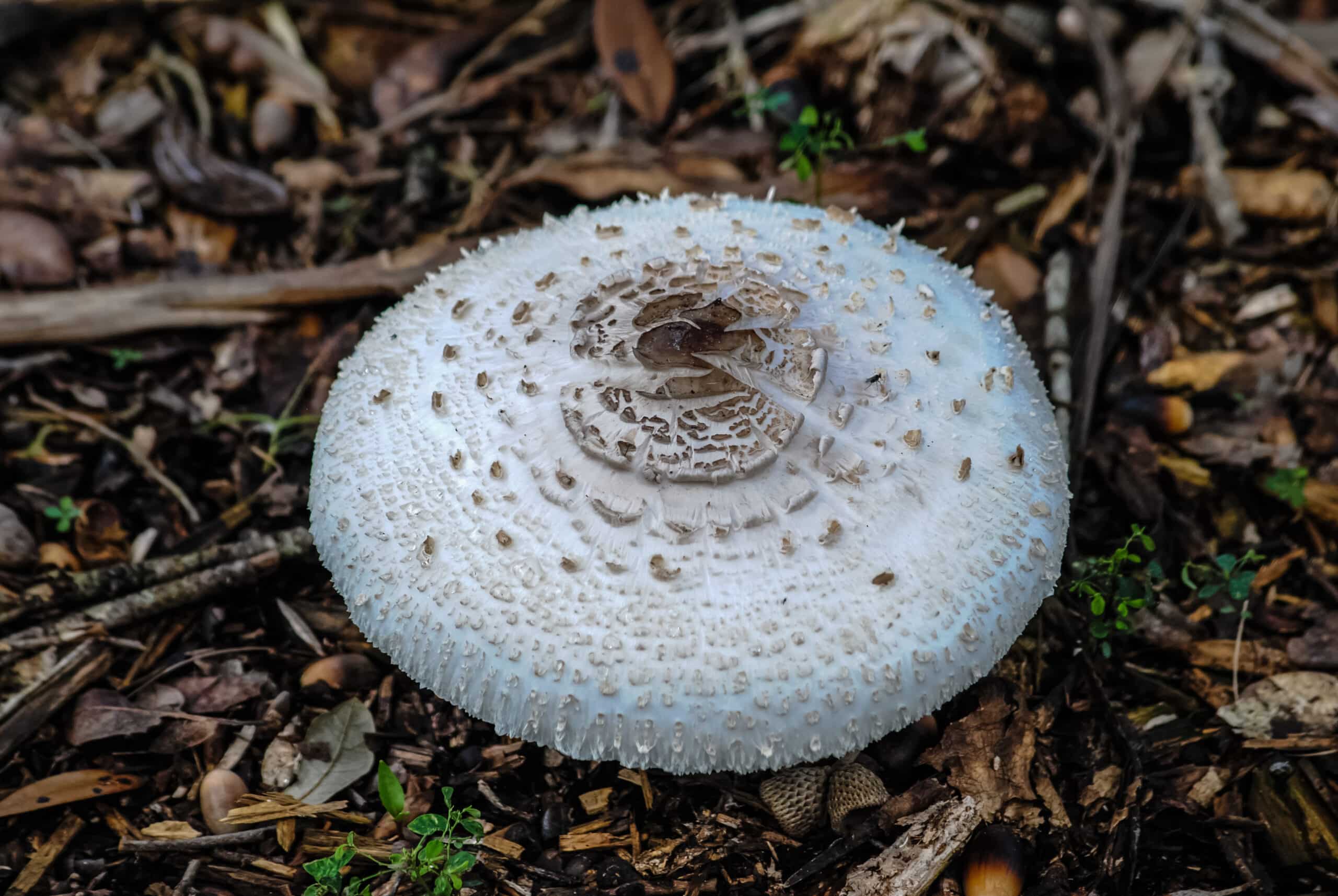
The cap, or pileus, of a mushroom isn’t just its most visible part; it’s a critical structure that contributes significantly to the mushroom’s reproductive and protective functions. Caps can vary dramatically across different species, displaying a wide range of shapes, sizes, colors, and textures, each adapted to the specific environmental conditions and reproductive needs of the fungus.
Description
Mushroom caps can appear in several forms:
- Convex: Rounded upward, like a dome, often seen in young specimens.
- Flat: Spreads out flatly as the mushroom matures, maximizing the area for spore release.
- Bell-shaped: Resembles a bell, common in many wild mushrooms.
- Conical: Tapered to a point, often found in more exotic species.
The texture of a cap can also tell much about its species and age. Some are smooth and glossy, while others are scaly or ribbed, providing cues for identification and ecological function.
Function
The primary function of the mushroom cap is to protect the spore-producing gills, pores, or tubes located underneath from environmental elements like wind and rain. This protection ensures that spores develop optimally and are ready for effective dispersal at the right time.
Varieties
The diversity in cap types is immense, each suited to the mushroom’s lifecycle and habitat:
- Shiitake (Lentinula edodes): Known for its broad, umbrella-like cap, which protects its spores from excess moisture while facilitating spore dispersal beneath.
- Fly Agaric (Amanita muscaria): Features a distinctive red cap with white spots, which helps in warding off predators while being highly visible as a warning for its toxicity.
- Morels (Morchella spp.): Exhibit a completely different approach with a honeycomb-like cap structure, which increases the surface area for spore dispersal.
This variety not only aids in the practical aspects of survival and reproduction but also attracts the attention of foragers, researchers, and nature enthusiasts, making the cap a focal point in mushroom identification and study.
2. Gills (Lamellae)
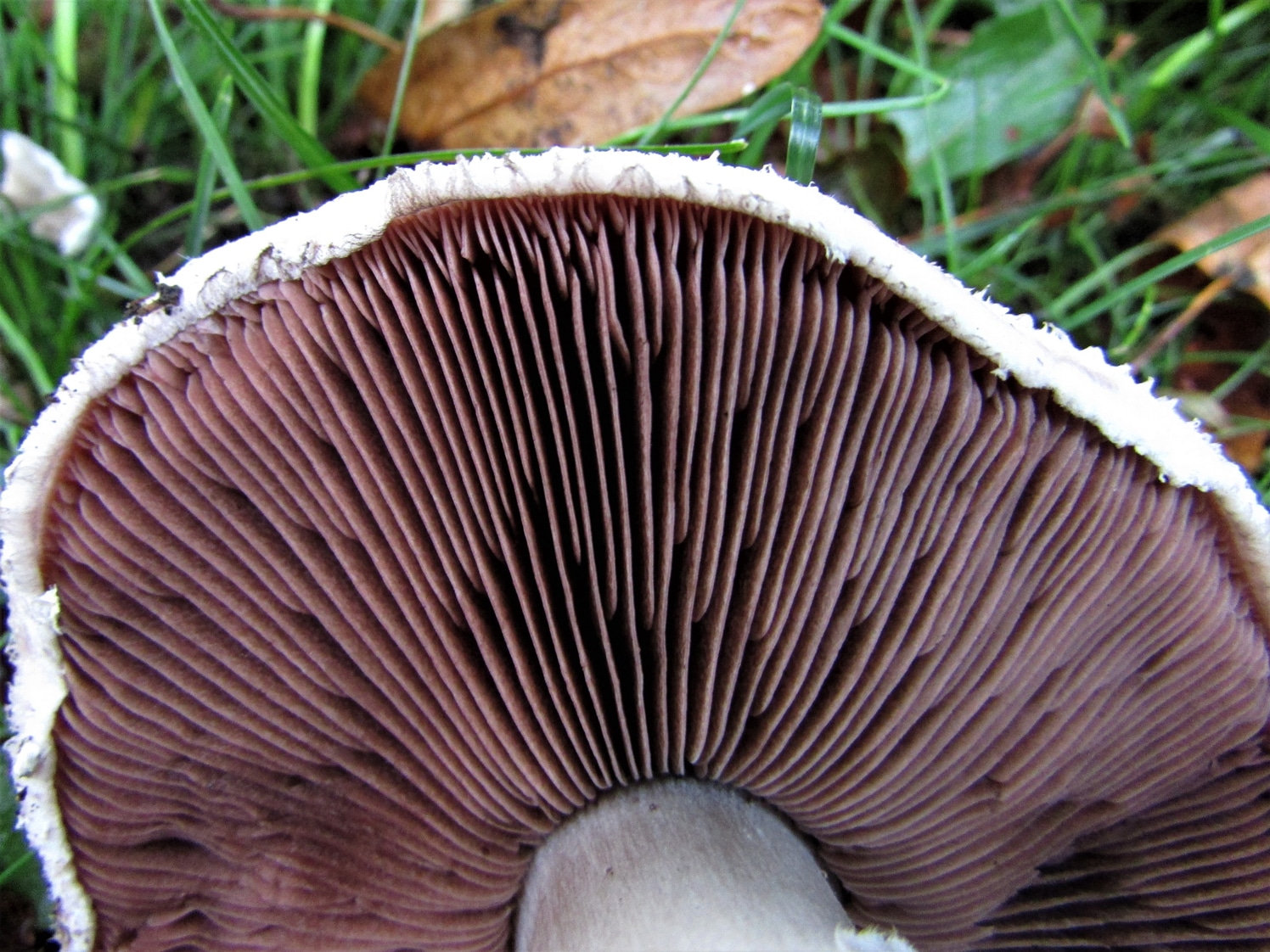
The gills, or lamellae, are among the most distinctive and important structures in many mushroom species, primarily responsible for spore production and dispersal. Located on the underside of the mushroom cap, gills are thin, paper-like structures that radiate outward from the mushroom’s stem. Their design is not only functional but also varies significantly among species, influencing both the method and efficiency of spore dispersal.
Structure
Gills are characterized by their delicate, rib-like appearance, which can vary in density and pattern:
- Close Gills: Found in mushrooms like the common white button mushroom, these gills are tightly packed, which can help protect developing spores from moisture and physical disturbances.
- Distant Gills: Seen in species like shiitake, these are spaced more widely, allowing for easy drop-off of mature spores.
- Forked Gills: Some species, such as the chanterelle, exhibit gills that branch or fork, a feature that can help differentiate them from look-alikes.
Gills are often attached to the stem in different ways—some are free, not touching the stem at all, while others may be adnate or decurrent, running partway or entirely down the stem. These attachment styles can be key indicators in mushroom identification.
Purpose
The primary role of gills is to increase the surface area for spore production. Each gill is lined with microscopic structures called basidia, where spores develop before being released into the environment. The design of the gills ensures maximum spore release, as air currents flowing under the cap can effectively catch and distribute spores over wide areas.
Variations
Different gill structures play significant roles in how effectively a mushroom can spread its spores:
- Color Variations: The color of gills can vary widely—from white and cream to dark brown or black—which can help in distinguishing edible species from potentially poisonous ones.
- Inter-gill Spacing: The spacing between gills can affect the rate and pattern of spore drop, which is crucial for the dispersal mechanism and subsequent colonization of new areas.
Understanding these variations not only assists in identification but also provides insights into the evolutionary adaptations mushrooms have developed to thrive in diverse environments.
3. Spores
Spores are fundamental to the reproduction and survival of fungi, serving as the equivalent of seeds in the plant kingdom. These microscopic entities are produced in vast quantities by mushrooms and are critical for the propagation of fungal species across various environments.
Definition
Spores are tiny, reproductive cells capable of developing into new fungal organisms. They are produced by the basidia located within the gills, pores, or tubes of mushrooms, depending on the species. Each spore contains all the necessary genetic material to grow into a new fungus when conditions are favorable.
Spore Print
One of the most intriguing and practical methods for studying mushroom spores is the creation of a spore print. This process involves removing the cap of the mushroom and placing it gill-side down on a piece of paper or glass. After several hours, the spores fall out of the gills and settle onto the surface, leaving a pattern that reflects the gill structure. This print not only helps in identifying the species due to its unique color and pattern but also serves as a beautiful and unique form of natural art.
Color Variations
The color of spores is a critical characteristic used in mushroom identification. Spore colors can range widely:
- White to Cream: Common in many edible species, such as the button mushroom.
- Brown to Black: Seen in species like the portobello or shiitake.
- Pink, Purple, or Rust: Less common and can indicate specific genera like Rhodotus or Cortinarius.
Each color variation has implications for classifying and understanding mushrooms, as certain colors often correlate with specific families or genera.
4. Stem (Stipe)
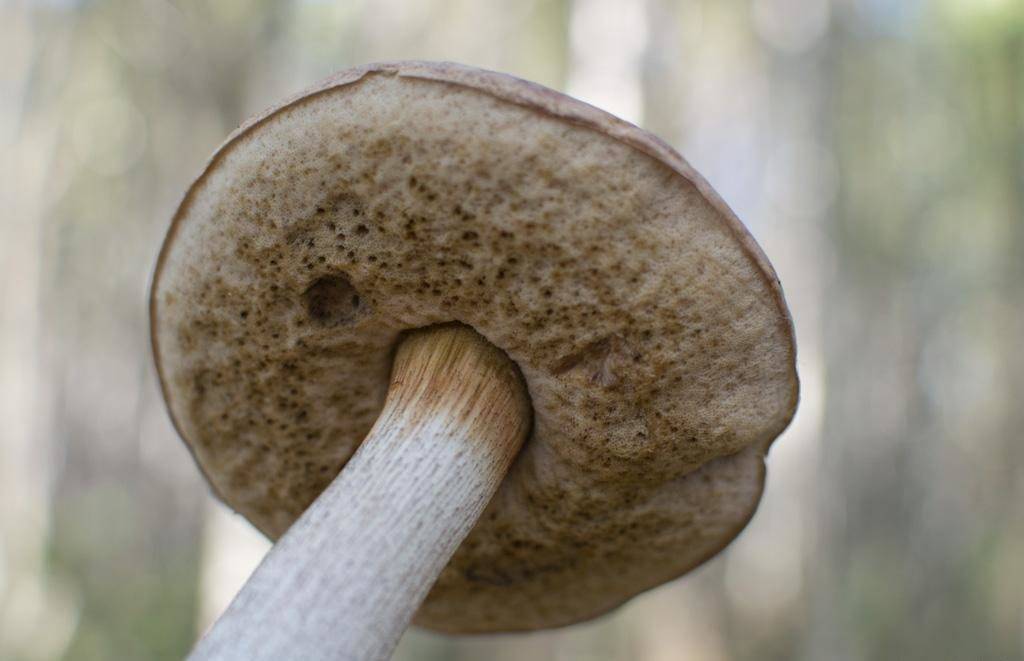
The stem, or stipe, of a mushroom is more than just a support structure. It plays a vital role in the lifecycle and functionality of the fungus, particularly in terms of elevating the reproductive structures to facilitate spore dispersal. The stem’s characteristics—such as its length, thickness, texture, and color—vary widely among species and can provide significant clues for identification.
Description
The stem can vary greatly in appearance, reflecting the ecological adaptations and evolutionary strategies of different fungi:
- Size and Shape: Stems can be long and slender, short and stout, or even absent in some species. For instance, the common field mushroom has a relatively short, sturdy stem, while the oyster mushroom may have no distinct stem at all, growing laterally from its substrate.
- Texture: The texture of the stem can range from smooth and silky to fibrous and scaly. Some stems might also exhibit a sticky or slimy coating, which can help in moisture retention and deter predators.
- Color: Stems may be uniform in color, match the cap, or have distinct colorations and patterns. These variations can be crucial for distinguishing between species, particularly in genera where cap colors and textures are similar.
Function
The primary function of the mushroom stem is to elevate the cap, optimizing the exposure of the spores to air currents for dispersal. The stem’s height and rigidity are therefore crucial in ensuring that spores are released effectively into the environment.
Types
There are several distinct types of stems that reflect the diversity within the fungal kingdom:
- Central Stems: Typical of many mushrooms, these are centrally located and provide balanced support for the cap.
- Lateral Stems: Found in mushrooms like oyster mushrooms, where the stem grows to one side, often when the mushroom emerges from wood.
- Rhizomorphs: While not traditional stems, these root-like structures can function similarly by supporting clusters of fruiting bodies. They are common in fungi like Armillaria, or honey fungus.
5. Veil (Partial and Universal)
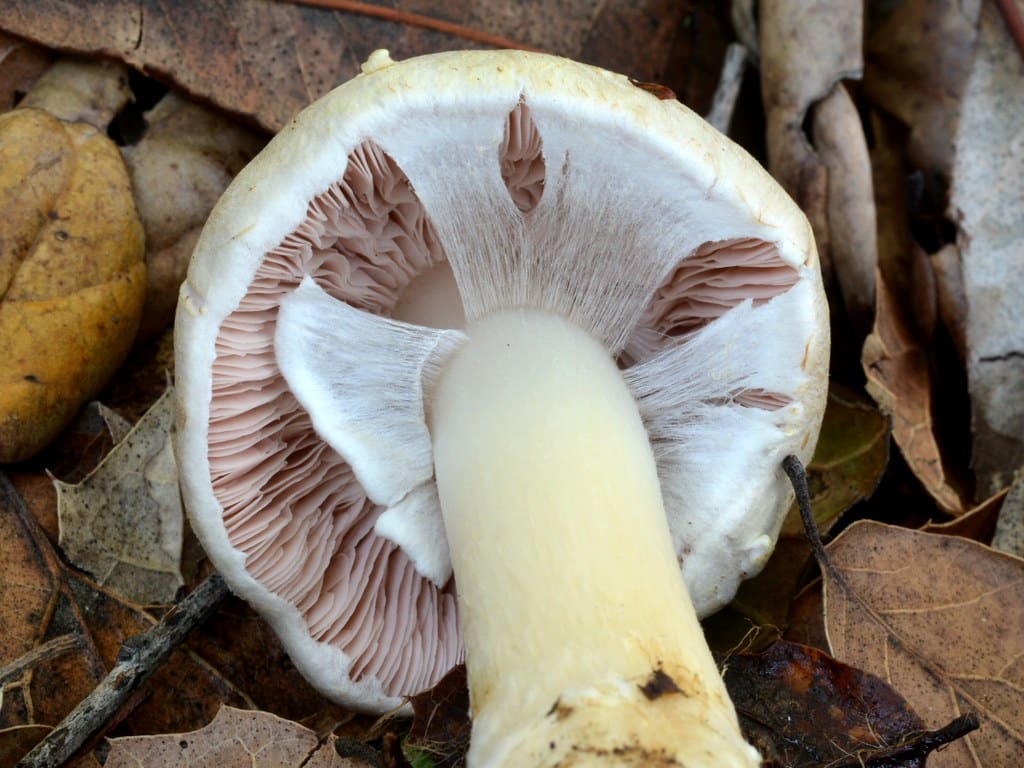
The veil in mushrooms is a temporary structure that plays a critical role during the early stages of development. It encompasses two main types: the partial veil and the universal veil, each serving distinct protective functions as the mushroom matures. Understanding these structures is essential for identification and appreciating the developmental intricacies of various fungal species.
Partial Veil
The partial veil is a membranous layer that extends from the stem to the edge of the cap, covering the immature gills or pores. This veil serves to protect the developing spore-producing structures from environmental hazards and potential pathogens during the critical early phase of growth.
Function
As the mushroom grows and the cap expands, the partial veil eventually tears. In many species, remnants of this veil can remain on the stem as a ring or annulus, or adhere to the rim of the cap. These remnants are significant identification features in many mushrooms, such as the common Portobello.
Universal Veil
The universal veil completely encases the young mushroom, forming a protective layer around the entire fruiting body. As the mushroom matures and expands, this veil ruptures, leaving behind pieces that can be found at the base of the stem (as a volva) or as warty patches on the cap.
Function
The universal veil’s remnants are crucial for identifying certain groups of mushrooms, particularly the genus Amanita, which includes both edible and highly toxic species. The presence of a volva and other veil remnants can be key indicators of specific Amanita species, such as the deadly Amanita phalloides (death cap) and Amanita muscaria (fly agaric).
Identification
The characteristics of the veils, including their texture, color, and how they break, are vital for mushroom identification. Observations of how the veil remnants are positioned and their appearance can help differentiate closely related species, which might be visually similar but differ significantly in toxicity.
6. Volva

The volva is a specialized structure in certain mushrooms, particularly prominent in the Amanita family, which includes both highly esteemed edibles and some of the most toxic species known. This structure is essentially a remnant of the universal veil and appears as a cup-like enclosure at the mushroom’s base, playing a crucial role in the identification and classification of species within certain fungal genera.
Description
The volva is formed during the early growth stages of the mushroom, where it acts as a protective covering. As the mushroom matures and pushes upward, the universal veil ruptures, and the lower part remains at the base, forming the volva. This feature can be quite distinct, appearing as a bulbous, sack-like structure around the stem’s base, or it may be more subtle, manifesting as a slightly raised, collar-like area depending on the species.
Location and Appearance
In terms of location, the volva is found at the very base of the stem, typically partially buried in the substrate. It may be white, the same color as the stem, or take on a different hue, which can provide additional clues for identification. The texture may vary from smooth and membrane-like to rough and scaly, offering further distinctive characteristics.
Importance
The presence and characteristics of the volva are particularly significant when identifying mushrooms within the Amanita genus. For example:
- Amanita phalloides (Death Cap): Features a prominent, white volva that is often large and sack-like, critical for distinguishing it from less dangerous species.
- Amanita caesarea (Caesar’s Mushroom): Sports a volva that is more integrated and less distinct, part of what differentiates this edible species from its toxic relatives.
7. Mycelium
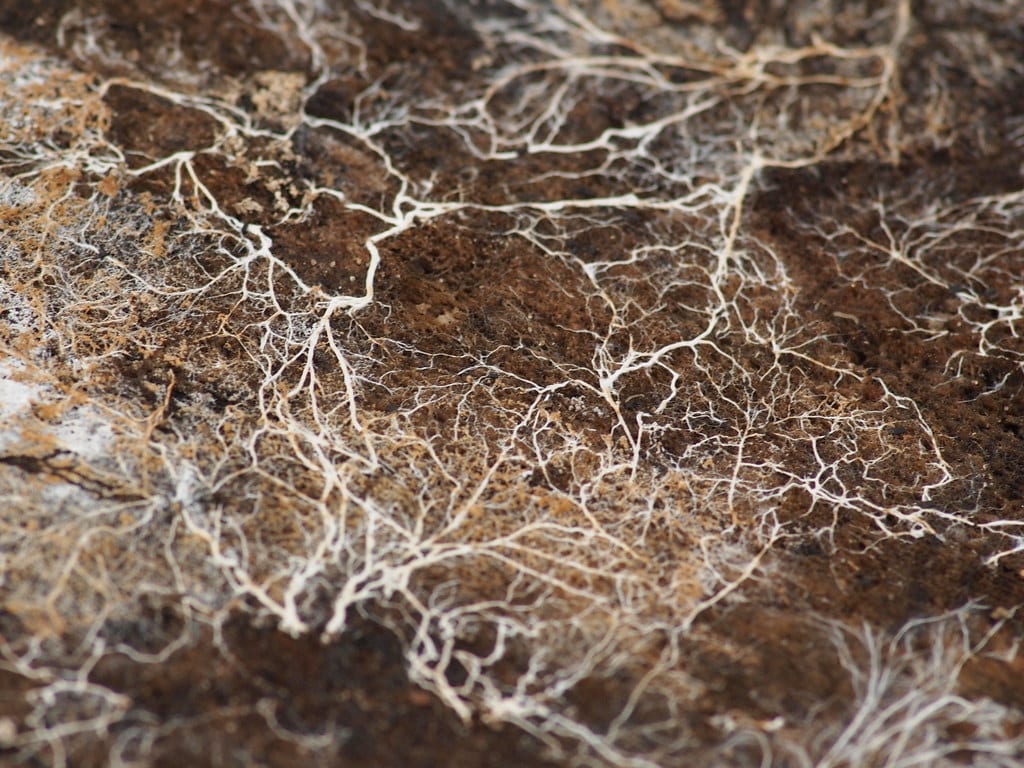
Mycelium is the vegetative part of a fungus, consisting of a network of fine, thread-like structures called hyphae. This extensive underground network is crucial for the survival, growth, and reproduction of fungi, playing a myriad of roles in both the ecosystem and the life cycle of the mushroom.
Definition
Mycelium is essentially the main body of the fungus, with the mushroom acting as the fruiting body for spore dispersal. The hyphae that make up the mycelium are minute and filamentous, spreading extensively through the soil or decomposing material to absorb nutrients.
Structure
The structure of mycelium can vary widely depending on the species and the environment. It can be densely packed and visible to the naked eye as white or creamy threads, or it might be so finely dispersed that it is barely noticeable. In some fungi, the mycelium forms more complex structures like rhizomorphs—long, root-like bundles of hyphae that can transport nutrients over longer distances and help colonize new areas.
Function
The primary role of the mycelium is nutrient absorption. It secretes enzymes that break down organic material, which is then absorbed as nutrients. This process not only sustains the fungus but also plays a critical role in the decomposition and nutrient cycling within ecosystems. Mycelium can also store nutrients, acting as a reservoir to support the fungus through unfavorable conditions.
Ecological Importance
Mycelium is vital for more than just the survival of the fungus. It contributes to the health of ecosystems in several ways:
- Soil Structure: Mycelium helps bind soil particles together, improving soil structure and preventing erosion.
- Decomposition: It speeds up the breakdown of organic matter, returning nutrients to the soil and supporting other plant and animal life.
- Symbiotic Relationships: Many fungi form symbiotic relationships with plants (mycorrhizal fungi), where the mycelium exchanges nutrients it gathers for carbohydrates from the plant. This relationship is crucial for the health and growth of many ecosystems.
8. Rhizomorphs
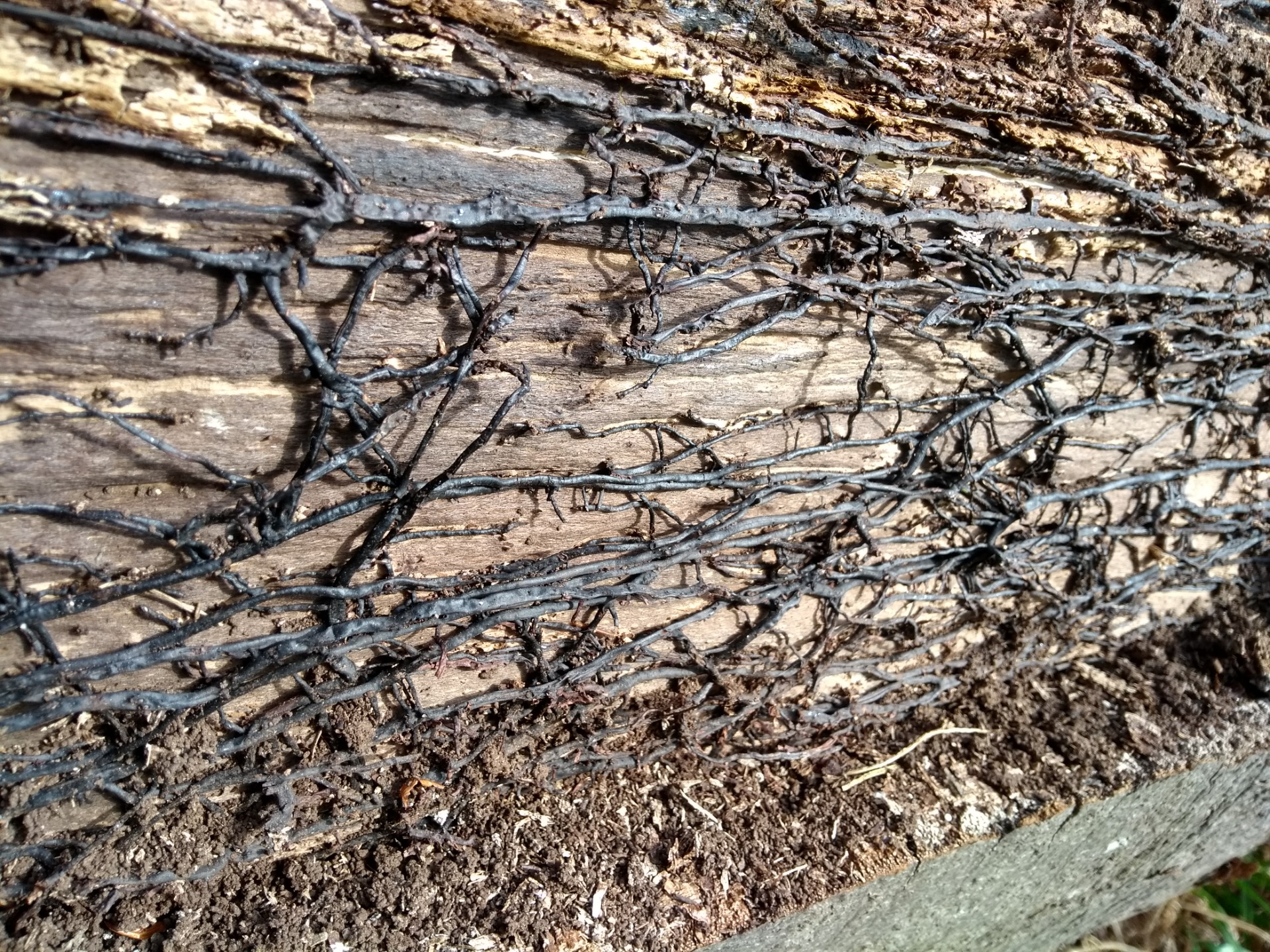
Rhizomorphs represent one of the more specialized structures within the fungal kingdom, often described as thick, cord-like aggregations of hyphae. These structures are particularly prominent in some species of fungi, where they serve as critical components in nutrient transport and environmental adaptation.
Description
Rhizomorphs are essentially bundles of hyphae that are compacted together to form rope-like structures. They often appear darker than the surrounding mycelium and can be visible on the surface of wood or soil. These structures can vary in length, sometimes stretching several meters, allowing fungi to bridge gaps between nutrient sources in their environment.
Function
The primary function of rhizomorphs is the efficient transport of water and nutrients over long distances, which is crucial for the colonization of new growth areas. This ability is especially important in environments where resources are scattered or in competitive ecological niches where reaching distant resources quickly can provide a significant survival advantage.
Ecological Role
Rhizomorphs play several vital roles in their ecosystems:
- Resource Allocation: They help distribute nutrients across the fungal colony, supporting growth in areas where nutrients are scarce.
- Colonization: Rhizomorphs enable fungi to colonize new areas rapidly, contributing to the fungal spread and the establishment of new mycelial networks.
- Symbiotic Relationships: In some cases, rhizomorphs facilitate interactions with plant roots, enhancing the symbiotic relationships that are critical for many ecosystems’ stability and growth.
Medicinal Parts of Mushrooms and their Benefits
Mushrooms have been revered for their medicinal properties for centuries, particularly in traditional Eastern medicine. Modern science is increasingly validating these uses through rigorous studies, revealing how various parts of mushrooms can provide significant health benefits. This section explores the medicinal components of mushrooms and the scientific evidence supporting their therapeutic potential.
Bioactive Compounds in Mushrooms
Mushrooms contain several bioactive compounds that contribute to their health benefits. These include polysaccharides, such as beta-glucans, terpenoids, sterols, and phenolic compounds. Each of these compounds plays a role in modulating the immune system, reducing inflammation, and protecting against chronic diseases.
Polysaccharides
Beta-glucans, found in the cell walls of many fungi, are particularly noted for their immune-enhancing properties. They help stimulate the immune system by activating white blood cells such as macrophages and natural killer cells, which are crucial for fighting infections and cancer cells. Studies have shown that the polysaccharides in mushrooms like Reishi (Ganoderma lucidum) and Shiitake (Lentinus edodes) can significantly boost immune function.
Link to study on beta-glucans and immune system
Terpenoids
Terpenoids in mushrooms have been studied for their potential anti-inflammatory and anticancer properties. For instance, triterpenes found in the Reishi mushroom have been shown to reduce inflammation and inhibit tumor growth in several laboratory studies.
Link to study on terpenoids in Reishi mushrooms
Antioxidant Properties
Mushrooms are also rich in antioxidants, which help combat oxidative stress and may reduce the risk of chronic diseases such as heart disease and cancer. The antioxidant content varies among different mushroom species, with Chaga mushrooms (Inonotus obliquus) often cited as having one of the highest levels.
Link to study on antioxidant properties of Chaga mushrooms
Medicinal Parts of Mushrooms
Various parts of the mushroom contribute to its medicinal benefits:
Caps and Stems
The caps and stems of mushrooms are commonly used in dietary supplements and teas. They contain high concentrations of polysaccharides and antioxidants. For example, the caps of Maitake mushrooms (Grifola frondosa) are particularly rich in beta-glucans known for their role in enhancing glucose metabolism and immune health.
Mycelium
The mycelium of certain mushroom species is cultivated for its potent biochemical profile. Mycelial products are often used in health supplements for their high concentration of bioactive molecules. Cordyceps, for instance, is almost exclusively cultivated as mycelium and is renowned for its energy-boosting and performance-enhancing effects.
Link to study on Cordyceps and performance enhancement
Clinical Evidence and Applications
Clinical trials have begun to explore the therapeutic applications of mushrooms in treating conditions like cancer, diabetes, and neurodegenerative diseases. While more research is needed, the results thus far underscore the potential of mushrooms as a complementary therapy in modern medicine.
Link to clinical trials on mushrooms
Understanding the medicinal parts of mushrooms and their benefits allows us to appreciate not just their culinary value but also their role in promoting health and wellness. As research continues to uncover the depth of mushrooms’ medicinal properties, their integration into healthcare practices is likely to expand, offering promising natural treatments for a variety of ailments.
Conclusion
The intricate world of mushrooms opens up a fascinating vista into the complexities of nature and its ingenious designs. Understanding the anatomy of a mushroom—from its protective cap down to the network of mycelium underground—does more than just satisfy our curiosity. It equips us with the knowledge necessary for responsible foraging, accurate identification, and a deeper appreciation of these remarkable organisms.
The various parts of a mushroom, each with its specialized functions, highlight the adaptability and efficiency of fungi. Whether it’s the cap acting as a shield for spores, or the mycelium absorbing nutrients from the environment, every component plays a crucial role in the survival and proliferation of the species. This synergy is not only a testament to the evolutionary success of fungi but also a reflection of their importance in maintaining ecological balance.
Moreover, the study of mushroom anatomy is not merely academic. It holds practical implications for environmental conservation, medicinal applications, and even sustainable technology. By fostering a deeper understanding of these organisms, we can better harness their potential and ensure they continue to thrive, benefiting our ecosystems and, indirectly, our lives.
Let this exploration of mushroom anatomy inspire you to further discover and respect these complex, often overlooked components of our natural world. There’s much to learn and even more to marvel at as we delve deeper into the study of fungi and their integral role in our environment.

